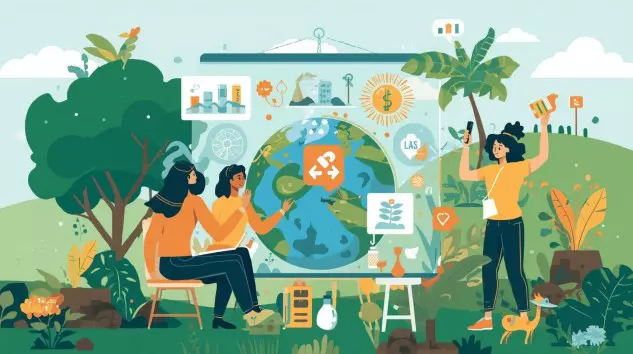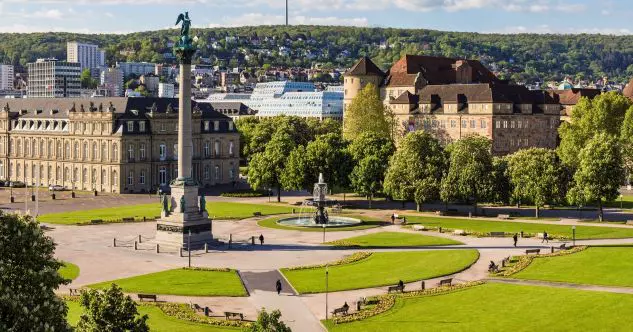Today’s global food systems are at the center of a profound paradox. Mass industrial agriculture has enabled the world to support unprecedented population growth, feeding billions and shaping modern societies. Yet the very processes that make this abundance possible are also responsible for widespread environmental degradation. Food systems exacerbate climate change, degrade soils, pollute water, and contribute to biodiversity loss on a global scale. The central challenge now is to build sustainable food systems, models of production and consumption that can feed a growing population without undermining the ecological foundations that make food production possible in the first place.
A system under pressure
According to the United Nations, food systems are responsible for approximately one-third of human-caused greenhouse gas emissions. A more granular assessment from the EDGAR-FOOD database, which integrates emissions across farming, land-use change, processing, transport, refrigeration, packaging, and consumption, estimates that in 2015 food-system emissions reached 18 gigatons of CO₂-equivalent – 34% of total global emissions. Notably, 71% of these emissions originated from agriculture and land-use change, while the remaining 29% came from the supply chain from cold storage to shipping and waste disposal.
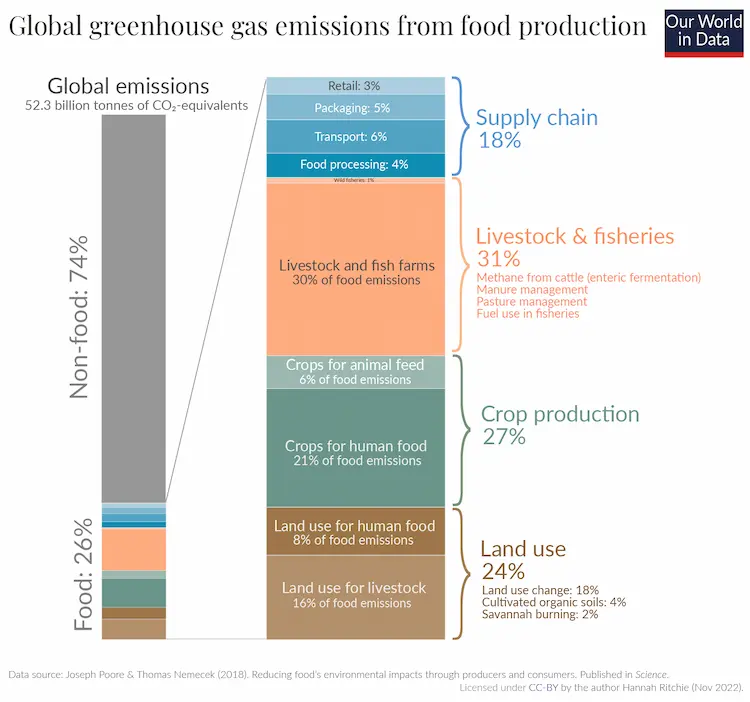
At the same time, hunger remains a daily reality. Conflict, climate instability, and market inequality keep more than 735 million people food-insecure (The Food and Agriculture Organization of the United Nations, 2023). The challenge is clear: how to feed a growing world without undermining the natural systems that sustain life.
“Business as usual” is not compatible with a stable future. Yet emerging innovations, both technological and ecological, suggest we may be able to reshape food systems to nourish both people and the planet. This scale of impact makes it clear: building sustainable food systems is essential if we are to feed a growing population while protecting the planet’s ecological foundation.
The hidden costs of mass food production
Industrial agriculture has been extraordinarily productive, but its ecological footprint is immense. Modern agriculture relies heavily on pesticides, antibiotics, and synthetic fertilizers that boost yields but degrade ecosystems. Runoff pollutes rivers and oceans, while antibiotic overuse accelerates antimicrobial resistance. Together, these pressures underscore the urgent need to rethink how sustainable food systems are designed and managed.
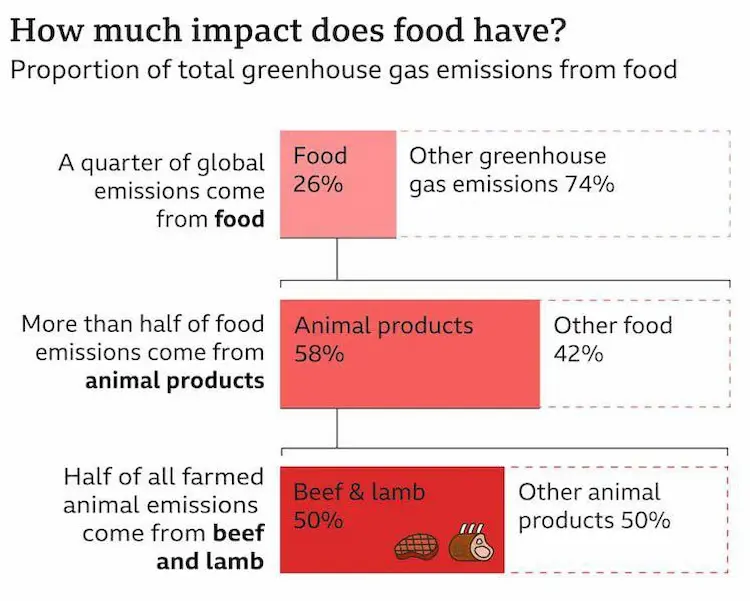
Pesticides and soil degradation
Decades of reliance on synthetic pesticides and fertilizers have increased yields, but at the cost of soil depletion and declining biodiversity. The UN has warned that a third of global soils are already degraded, with erosion happening up to 100 times faster than natural replenishment in intensively farmed landscapes.
By 2025, 1.7 billion people live in areas where land degradation is already reducing crop yields, with middle-income countries most affected. Farm size is a key factor: 85% of farms are under 2 hectares yet hold only a small share of global farmland, while a tiny fraction of very large farms control nearly half. Smallholders remain essential for food security, especially in lower-income regions, but are also the most vulnerable to environmental and market pressures. The Food and Agriculture Organization of the United Nations (FAO, 2025) emphasizes that land degradation is reversible through strategic investment in sustainable, land-friendly agricultural practices.
Antibiotics and livestock emissions
Livestock production accounts for roughly 14.5% of global greenhouse gas emissions (FAO), driven largely by methane, a gas with 80 times the warming potential of CO₂ over 20 years. Meanwhile, antibiotic use in industrial farming contributes to rising antimicrobial resistance, which the World Health Organisation (WHO) considers one of the world’s most urgent health threats.
The carbon footprint of food
The carbon footprint of food production varies dramatically. When comparing foods by carbon footprint, meat and dairy consistently emit more greenhouse gases than plant-based options, whether measured per kilogram, per calorie, or per gram of protein. Within animal products, larger animals are less efficient, with beef producing the highest emissions, followed by lamb, pork, chicken, and then eggs and fish. Compared – beef can emit up to 50 kg CO₂e per kilogram, while lentils emit less than 1 kg.
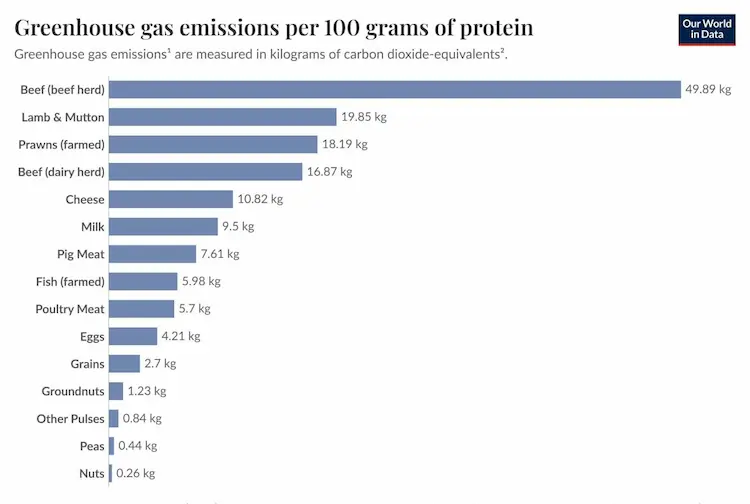
Transport, refrigeration, and packaging add layers of emissions, but the biggest driver remains production and land use. And yet, despite all this output, one-third of all food is lost or wasted, responsible for. Nearly one-third of all food is wasted, contributing 8–10% of global emissions. Reducing waste is one of the fastest strategies for a climate-friendly food transition.
This system is feeding us, but unsustainably.
Cultured meat and fish: alternative proteins for sustainable food systems
One of the most promising technological shifts comes from cellular agriculture. It is the production of animal protein from cultured cells rather than whole animals.
How it works
A small biopsy is taken from an animal. The selected cells are fed nutrients and grown in bioreactors that mimic natural muscle growth. The result is real meat, without raising or slaughtering animals.
Environmental potential
Life-cycle assessments suggest that cultivated meat could:
- Reduce land use by up to 95%
- Use 99% less water compared to industrial beef
- Dramatically lower methane emissions
Global Regulatory Progress
Singapore made history in 2020 by becoming the first country to approve cultivated meat, allowing Eat Just’s lab-grown chicken to be served in select restaurants and later sold in one grocery store, though the product still consists of only about 3% animal cells. Since then, progress has accelerated globally. In 2022–2024, the U.S., EU, and Israel each took steps to approve cultivated chicken, pork, and beef, though access remains limited to select restaurants and pilot tastings. These milestones show that cultured meat is gradually shifting from experiment to early market reality.
But the direction is clear: protein without livestock could become a pillar of future food security. Cellular agriculture, meat and fish grown from a single cell, represents one of the most transformative future of food tech innovations. Life-cycle assessments indicate substantial reductions in land use, water consumption, and methane emissions. However, production remains energy-intensive. Scaling will require renewable power and supportive policy frameworks.
Regenerative agriculture and organic fertilizers
Synthetic nitrogen fertilizers, derived largely from natural gas, have fueled global crop expansion, but they also contribute to water pollution, nitrous oxide emissions, and loss of soil fertility.

At the same time, time-tested approaches are making a return. Traditional practices are re-emerging:
- Compost and manure return organic matter to depleted soils
- Nitrogen-fixing cover crops (e.g., clover, alfalfa) naturally enrich soil
- Biofertilizers use microbes to improve nutrient uptake
Regenerative agriculture is already being adopted in regions where soil loss threatens long-term yields. While initial transitions can reduce output, over time, healthier soils retain moisture, resist drought, and sustain productivity.
This is agriculture that builds ecosystems rather than depleting them. The shift from synthetic fertilizers to regenerative soil practices, composting, crop rotation, and nitrogen-fixing cover crops, strengthens soil structure and reduces chemical runoff. Farmers using regenerative agriculture solutions report increased resilience to drought and long-term yield stability. Transition costs remain a barrier; training and financial incentives are essential.
Seasonal and local diets: healthy sustainable diets
Eating locally and seasonally reconnects us with nature’s rhythms and supports our communities, in contrast to the global, year-round food supply of modern systems. Global trade gives consumers tomatoes in winter and mangoes in cold climates, but the logistics behind this convenience are carbon-intensive.
Seasonal and regional food systems can:
- Reduce the carbon footprint associated with transport and refrigeration.
- Support local farmers and shorter supply chains.
- Improve dietary diversity and freshness.
This shift is not about limiting choice; it’s about realignment with natural cycles, a principle embedded in most culinary traditions before the era of global shipping.
Choosing seasonal, locally grown foods supports low-carbon diets and reduces emissions from refrigeration, packaging, and transport. A seasonal food calendar can help with choices.
This approach also aligns with WHO recommendations for healthy, sustainable diets, diets that are nutritious and environmentally responsible.
Urban farming and the circular food economy
Urban farming and circular food systems offer a way to bring food production closer to where people live, reducing transport emissions and strengthening community resilience. By integrating gardens, greenhouses, and composting into city planning, urban areas can become greener, healthier, and more self-sufficient. As cities grow, so does interest in hyper-local food production:
- Home gardens lower food bills and increase nutritional resilience.
- Community gardens reduce food insecurity and strengthen social ties.
- Urban farms (rooftop greenhouses, hydroponic towers) supply local markets.
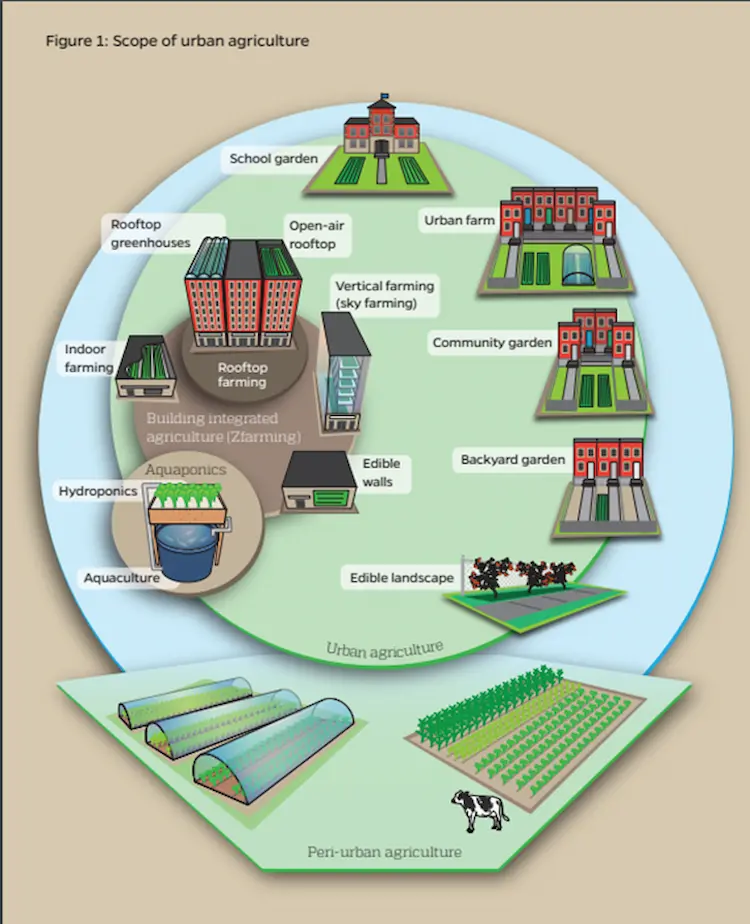
In our previous materials, we explored the rise of urban gardens and how cities are reclaiming green space for local food production. You can find the full overview in our journal here.
Cities like Paris, Detroit, and Singapore are exploring urban farming as part of climate adaptation and public health strategies. While urban agriculture will not replace rural farming, it can supplement it significantly, particularly in fresh produce.
Read more about Singapore here and here.
Urban farming, from community gardens to rooftop greenhouses and vertical farms, strengthens resilient food supply chains by reducing dependence on long-distance imports. Cities experimenting with circular food economy strategies are also reusing organic waste as compost and biofertilizer.
Improved logistics, storage, consumer education, and incentives for redistribution are key food waste reduction strategies that can significantly reduce emissions and enhance food security. The MyEmissions food footprint calculator helps consumers visualize this impact in personal terms.
Ultimately, the transition to sustainable food systems necessitates innovation, policy reform, and cultural transformation. No single solution is enough, but together, alternative proteins, regenerative agriculture, seasonal diets, urban farming, and waste reduction can reshape how we feed the world. The challenge is significant, but the opportunity is larger: to build a food system that nourishes people while restoring the planet.
